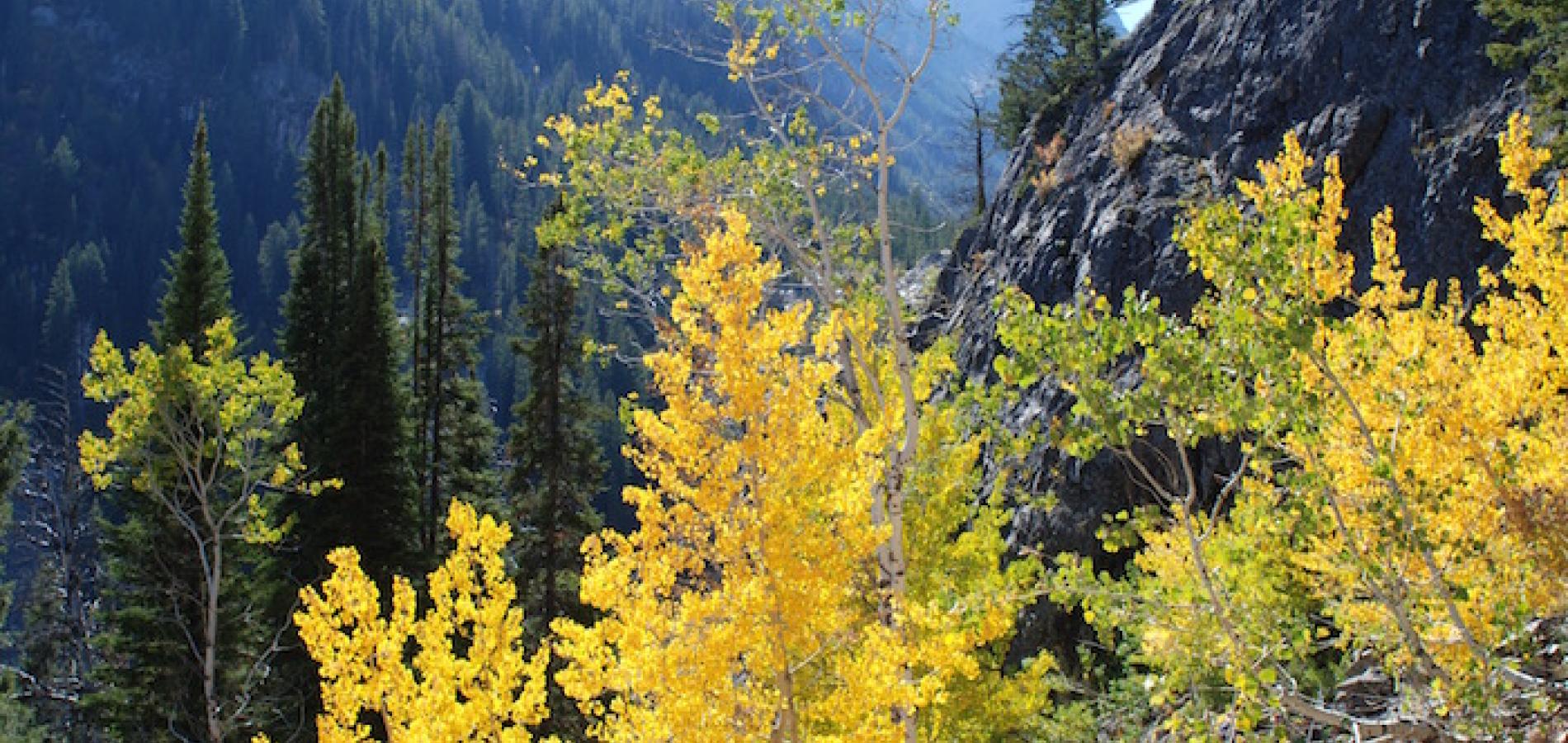Fall in the Rocky Mountain parks isn’t quite as colorful as the season is back East, as they lack the endless acres of hardwood forests. But the high peaks, sometimes dusted in snow, make up for that. Watch the aspens, larch, scrub oak and maples paint the landscape with masterful strokes.
Rocky Mountain National Park, Colorado
In Rocky Mountain National Park a sunlit afternoon in late September can surround you with sweeping vistas of gold set against the green of evergreens. Time your visit for late afternoon or early evening and you just might be able to pair the colorful surroundings with the shrill whistling of bugling elk.
From Estes Park, enter the park via the Beaver Meadows Entrance and then turn left onto the Bear Lake Road. Stop in Moraine Park for a short hike along the Cub Lake Trail to enjoy the deep reds and yellows of the riparian vegetation, or choose a hike in Glacier Basin, to Sprague Lake, or one of those whose trailheads head off from the Bear Lake parking area.
Recommended hike: From Bear Lake, head up to Nymph, Dream, and Emerald lakes.

Though the color season might be short in Western parks, there are many great color hikes to take, such as this one in Glacier National Park/NPS
Glacier National Park, Montana
Glacier National Park in Montana takes on golden tints thanks to an unusual evergreen: the larch. Found mainly on the western side of Glacier, the trees that rise to 150 feet turn a vibrant gold, usually by mid-October, before dropping their needles like hardwoods drop their leaves.
Park officials suggest a ride along Highway 2, which runs along Glacier’s southern boundary, to get the best views of these trees.
By mid-September the park can have showy, vibrant orange displays of Rocky Mountain maple, and red and orange vaccinium (huckleberries, whortleberries). As the month wears on and October gets under way, the colors descend, generating gorgeous yellow, gold, and orange birch, cottonwood, and aspen at mid-elevations.
Recommended hike: Leave Lake McDonald behind for the gentle, colorful, walk to Avalanche Lake for an afternoon picnic.
Grand Teton National Park, Wyoming
Grand Teton National Park’s color season can be short and spectacular as groves of aspen on the park’s flats and mountainsides and stands of cottonwoods along river bottoms shimmer with gold in mid- to late- September.
The Jenny Lake area is a renowned destination, though if you cruise along the Moose-Wilson Road you’re eyes will feast on vibrant aspens contrasted by the rouge of chokecherry and huckleberry bushes… whose tasty berries also lure bears, black and grizzlies. And, of course, the peaks are always towering above.
Recommended hike: Turn your back on the crowds at Jenny Lake and instead head for Phelps Lake up from the Laurance S. Rockefeller Preserve.
Canyon de Chelly National Monument, Arizona
Canyon de Chelly National Monument, located on a Navajo Indian Reservation in the Four Corners region of northeastern Arizona, does not normally leap to mind when you think of fall foliage. But the park’s river-bottom aspens and cottonwoods are gilded in gold and yellow by late October, and the blend of brilliant foliage and ruddy sandstone cliffs is especially pleasing.
Scenic drives from the visitor center and along the canyon rim lead to ten overlooks (three on the North Rim Drive and seven on the South Rim Drive) providing excellent views of the canyon below.
Recommended experience: Spend a day with a Navajo guide touring the canyon floor with its rich Native American history.

Though there's a lot of redrock, Canyon de Chelly still has lots of golden cottonwoods to add contrast in fall, as this shot from Tseyi Overlook attests/NPS
Mount Rainier National Park, Washington
Mount Rainier National Park in Washington takes on a rich, red appearance in fall as vine maple and huckleberry bushes turn. Tossing contrast into the scene are the yellows of cottonwoods and willows, reds of mountain ash, and golds of tamarack, another species of larch.
The leaves begin turning in early September. If you hit the leaves at their peak (usually late September to early October), driving on State Route 410 through Chinook Pass or on the White Pass Scenic Byway (U.S. 12) will be a truly memorable experience. In the Chinook Pass and White Pass areas, you can still see gloriously golden tamarack when the serious snow begins to fall in November.
Park your car and hike around Reflection Lakes, where the bright stands of mountain ash are offset by the yellows of hellebore.
Recommended hike: If you’ve got some energy after Reflection Lakes, hike down to Narada Falls to catch the stink currants and Devil’s club that add reds and yellows to the setting.






 Support Essential Coverage of Essential Places
Support Essential Coverage of Essential Places







Comments
Great pictures and hike recommendations. For people looking to extend their fall color season, Zion NP also has gorgeous fall color and probably won't reach it's peak till the first week of November.